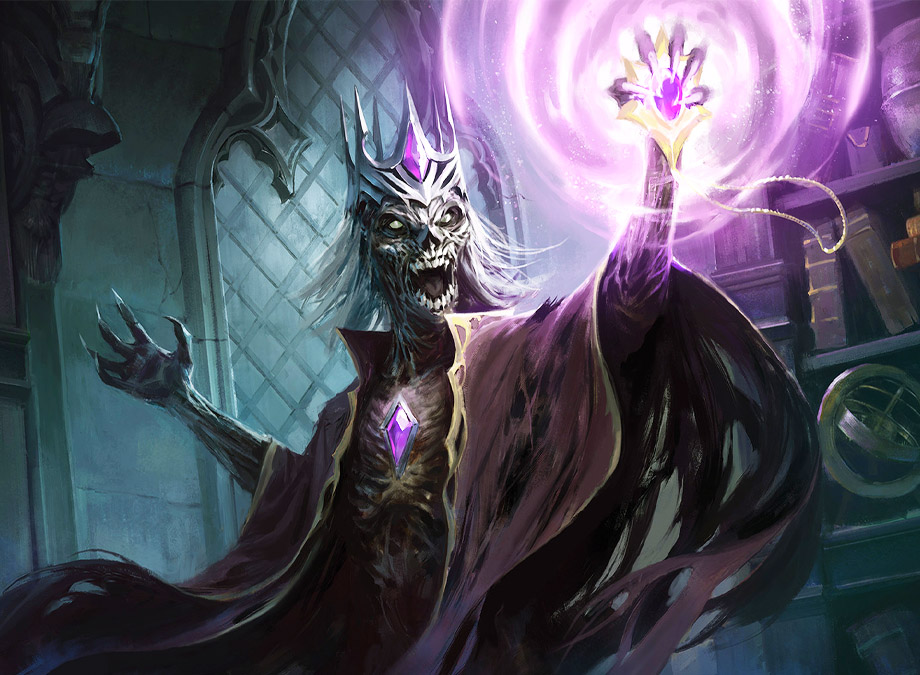Beware the hordes of the undead!
Whether they be skeletons, mummies, shades or zombies, those raised from the grave are seldom a good omen. You’ve likely heard stories about what these creatures are capable of if you haven’t encountered them yourself.
When it comes to these shambling piles of rotting meat, skeletons and zombies are often the least of your worries. Or, at least, so long as we’re talking your average run-of-the-mill, magically animated zombies. Zombies created through transmissible diseases are another matter altogether.
More dangerous are those undead who can inflict status effects upon the party. Whether it’s draining levels, stealing away your strength, or infecting you with diseases. Some of them may even turn members of your own party into monstrosities such as them.
But out of all the undead, there is one that inspires terror in all that hear the name: the jewel upon the bony crown.
The lich.
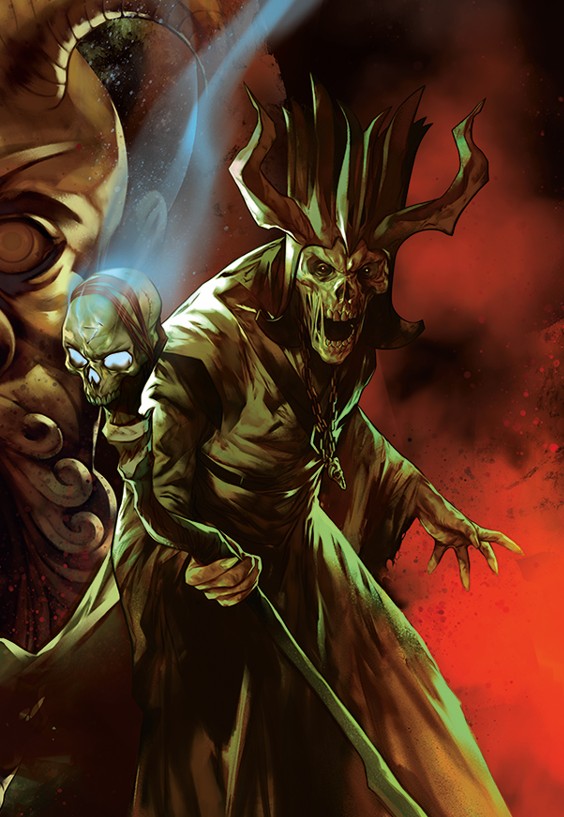
You know, like this guy!
Or… rather, liches.
All know the tales of these powerful undead, and yet some may still ask: What, exactly, is a lich?
Well, have no fear for I am happy to dive into this matter and explain.
Welcome to Lore-Win, the Dungeons and Dragons lore series. I, as always, am your humble Loremaster, Sokar. Today we’ll be looking at all the forms of liches and discussing the differences between them.
Liches
Liches come in many forms, and in fact, we can see at least two of these forms in the example of Acererak. His original form of a demilich has a distinctly different appearance from how he appeared in Chult as a lich.
Liches, generally, are the more humanoid form of liches. Whereas demiliches appear as a skull, often with jewels for eyes, liches have a full body — skeletal and weathered though it may be.
Common traits of liches is that they are nigh-universally evil, as you might expect from a form of undead that eats souls to sustain itself, and being powerful spellcasters. Generally, liches are wizards who have found a way to transcend death and keep their arcane powers. However, sorcerers and warlocks have also been known to become liches.
Generally, to become a lich a spellcaster must have a certain amount of pride. After all, choosing to live (or rather exist) forever at the cost of harming others takes a certain ego to achieve. Generally, liches appear either skeletal in nature, or with leathery, weathered skin, looking like a mummy of sorts.
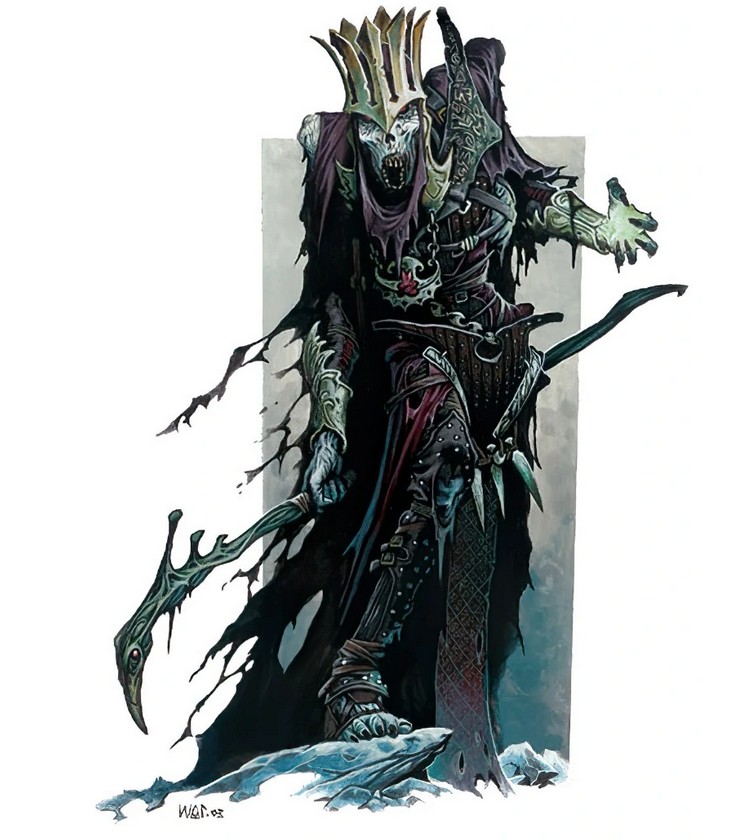
When you wear a crown as a powerful undead, you're really wearing it for yourself.
Source: Monster Manual (3.5)
Given that liches are so decomposed, one may wonder how it is that they can speak. And to be honest, they can’t. They have no need to breathe, and their lungs have long since rotted away. What they can do is project speech magically. They may even move their jaw along with the words to help the illusion.
Again, becoming a lich requires a certain level of ego. And ego often goes along with drama hand in hand.
Part of the process of becoming a lich is the creation of a phylactery. This is a magical object that contains the lich’s life essence or soul. Phylacteries can take on many appearances, some are metal boxes with parchment inside, but others may be amulets, rings, or some small trinkets.
If a lich is destroyed, but their phylactery remains intact, the undead spellcaster will begin to reform at its location. Hence, liches often go through great pains to ensure their phylacteries remain safe.
Like, keeping it in a tomb full of traps intended to harvest souls, for example.
Of course, within even this lowest level of lich there are several variations of lichdom.
Alhoon
For example, the Alhoon.
Many liches appear to have been human, or humanoid at least, in life. However, Alhoons have a different appearance to them.
Among the psionic Illithids, there are some heretics who break from their Elder Brain masters and hiveminds to pursue more magical endeavours. Some of these may pursue undeath, to continue their pursuits long past the end of their natural lives.
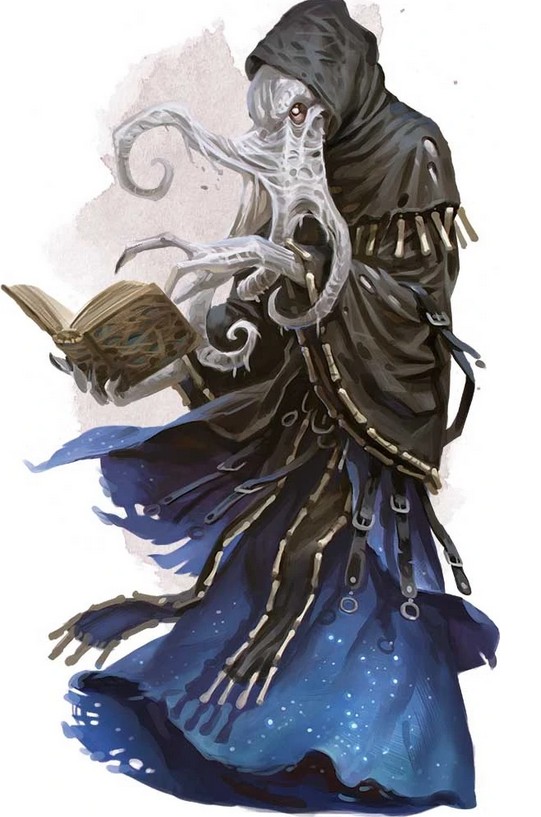
Somehow, I find them less terrifying than other liches.
Source: Volo's Guide to Monsters (5e)
Technically speaking, there are two forms of these Illithid liches. Alhoons possess a more limited lichdom, while the most powerful of Mind Flayer liches are known as the less inspired name, Illithilich. But, it’s doubtful that any who would see either would be present minded enough to discern the distinction.
Alhoons (and Ilithiliches by extension) have dried-out skin, but otherwise appear nearly identical to their living kin. And like their living kin, they can also eat and drink, should they want to. Many still eat brains, letting them see into the memories of said brains.
Of course, being arcane in nature, Alhoons are hated by Ilithid society, and are known to band together to defend against other threats.
Baneliches
Followers of the god Bane have also been known to resurrect as liches of a sort.
Notably, Baneliches were unlike their fellows in one major aspect: where most liches were arcane in nature, Baneliches were divine.
Dismayed by how many of his loyal followers had been slain by the forces of good, Bane took matters into his own hands. He approached one of his most loyal followers and revealed to him a way to transcend death itself. This follower, in turn, became a Banelich, and remained faithful to his god.
Bane repeated this process every 50-or-so years, and made 35 Baneliches. Or, thereabouts at least. Luckily for the forces of good, many of these were destroyed, but some survived and continued to plot and scheme the way that only those who cannot die do.
Archlich
Where most liches are evil, there are exceptions. These are known as Archliches, and in another difference from regular liches, they did not have phylacteries. Archliches instead choose a more practical magical item to house their souls. These might be things like small spellbooks, or other such items that serve a more immediate use.
An Archlich was a person devoted to noble goals in life that continue to pursue these goals into their post-life existence. Appearance-wise, Archliches are indistinguishable from other liches, but they often have much different personalities.
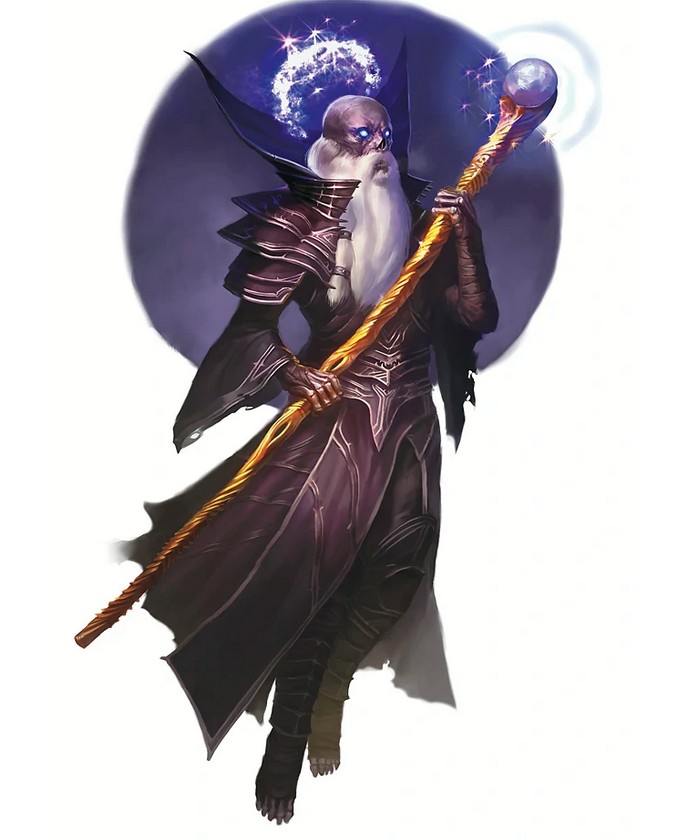
Still creepy looking. The halo is a nice touch though.
Source: Arcane Power Excerpts: Archlich (4e)
Notably, Archliches tend to try and avoid combat. They also tended to retain more of their humanity in undeath, their minds staying more stable even in their decomposed form. Archliches have been known to befriend other agents of good, and to enjoy food, drink, and even sometimes fall in love.
To become an Archlich, a noble individual had to drink a special potion while holding their magical item, which they had to have a hand in creating, covered partially in the spellcaster’s blood, while a spell was cast. This process was not a guaranteed success, and there was a chance that the individual would die in the process. This chance grew to a guaranteed death if the individual was unwilling.
Baelnorn
Among Archliches though, there was another form: The Baelnorn. These elven liches tended to skew towards lawful good individuals who chose undeath to protect something. They may choose to safeguard a location, a community, or their family.
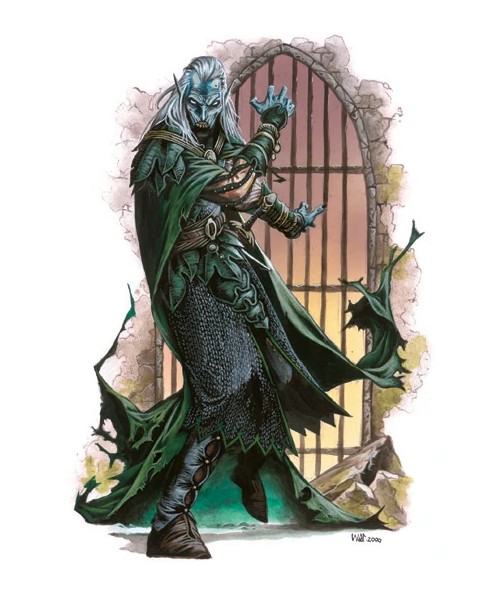
A weathered Baelnorn. Still, looking better than most liches.
Source: Monster Compendium: Monsters of Faerun (3e)
As such, most Baelnorn mostly embraced undeath, and were viewed more favourably in elven society than liches elsewhere. Historically, Baelnorns were seen as those who had made a great sacrifice for their people. In ancient elven civilizations, Baelnorns took on roles like advisors, guardians, and advisors, protecting travelers and training wizards.
Whatever task they had, Baelnorns devoted themselves to it. Even when the elven cities they served fell, many Baelnorns remained behind, watching over the ruins and protecting family heirlooms and vaults.
However, with the fall of the ancient elven cities, the spells and secrets behind the creation of a Baelnorn were lost. Still, some of them continue to exist, honing their skills. Baelnorns can send wraith-like projections of themselves to talk to others or scout regions. While younger, Baelnorns may appear as elves with slight differences, as they grow older they turn more skeletal in appearance.
Demilich
And back to the evil side of things.
While the “demi” in Demilich may imply that they are lesser than regular liches, that is very much not the case.
Yes, it is just a skull. Yes, it will kill you dead.
In fact, a demilich is the result of a lich that has evolved beyond the need for a physical body. This often occurred to wizards and sorcerers who had learned more about the nature of the arcane in their lichdom than mortals could comprehend.
In order to move past the need for a physical body, liches must first learn how to create soul gems. Then, they must replace eight parts of their own body with them, resulting in demiliches often having jeweled eyes and teeth.
However, the soul gems don’t need to be placed in a demilich’s head. They could also be joints in a hand, or discs in a spine. Whatever part of a body a lich chooses to place the soul gems in remains after their ascent to demilichdom while the rest of their body crumbles away.
These soul gems act like additional phylacteries, making a demilich incredibly annoying to destroy. So long as the gems or phylactery remain, a demilich will reform. So, you’d best be thorough.
Oh, and they have near total immunity, so maybe if you encounter one… run.
Dracolich
Whereas if you encounter a Dracolich, definitely run.
Run? From this cheery fellow?
It's not going to do you any good.
As the name implies, a Dracolich is a dragon that has achieved lichdom. It is a dragon who has voluntarily had its soul tied to a phylactery, with the Cult of the Dragon being responsible for this process on some dragons and attempting it on others.
However, something interesting about a Dracolich is that its body is not tied to its soul in the same way that other liches are connected to their bodies. If a Dracolich is destroyed, its soul returns to its phylactery. However, once it retreats there, it does not reform.
Instead, a Dracolich’s soul may inhabit the body of any dead reptilian creature. Even when it changes bodies though, a Dracolich retains its former abilities, including its breath weapon. Plus any auras of fear and spells it may have learned.
This makes a Dracolich exceptionally dangerous. And when inhabiting the body of a dragon, a Dracolich is at its most powerful. But of course, like any other lich, when its phylactery is destroyed, so is it.
Dracolichess play an important role in the Cult of the Dragon. The cultists believe that an apocalypse will strike the world, and Dracoliches will be the new gods, ruling over the world.
No matter the kind of lich though, many gods with the portfolio of death view them as abhorrent deviances. Things that must be put to rest to restore the balance of life and death. This includes even the noble Archliches, with clerics of Kelemvor trying to goad them into accepting rest, or find a way to settle their unfinished business and let them pass on.
Whatever the form of lich though, they can make an obstacle of some kind in high level campaigns. Not always as the direct antagonist, but sometimes as an ancient force scheming behind the scenes, or a guardian standing by to make sure that only the worthy claim the treasures of a long lost elven city.
And if inspiration has struck for a new undead antagonist for your campaign, make sure to stock up on your gaming supplies at the Tower.
Until next time, may all your rolls be crits.
-Loremaster Sokar

